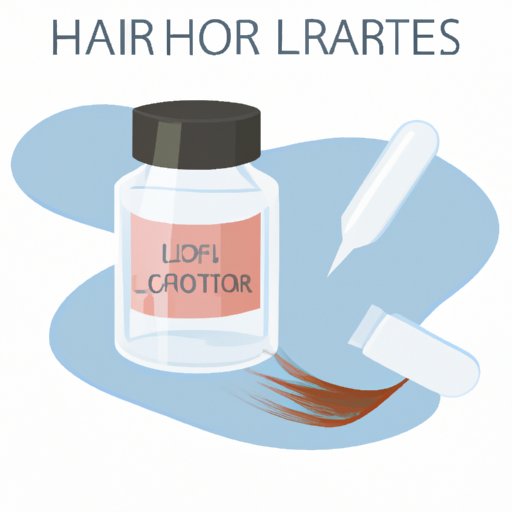I. Introduction
Hair loss is a common concern for people of all ages, gender, and ethnicity. It occurs when the hair follicles don’t function properly, leading to less hair growth or hair loss. Losing hair can have a significant impact on self-confidence and self-esteem, resulting in feelings of embarrassment, frustration, and helplessness.
There are many reasons why people experience hair loss, including genetic factors, hormonal changes, medical conditions, and environmental factors. In this article, we will explore different methods to prevent or stop hair loss, ranging from lifestyle changes, non-surgical treatments, medication, and hair transplant as a solution.
II. Preventing Hair Loss with Lifestyle Changes
The good news is that certain lifestyle changes can help prevent hair loss, or at least slow down the process. Exercising regularly and reducing stress are two effective ways to boost blood circulation and promote hair growth. When you exercise, you increase the blood flow and oxygenation to your scalp, which nourishes the hair follicles and stimulates hair growth. Stress can cause hormonal imbalances and inflammation, which can negatively impact hair growth and increase hair loss.
Another essential factor is diet. Eating a balanced diet that includes plenty of protein, vitamins, and minerals is essential for hair growth. Specifically, vitamins B, C, and D, iron, and zinc have been shown to help maintain healthy hair. Foods rich in these nutrients include fish, eggs, leafy greens, nuts, and seeds.
Finally, Haircare routine is essential to preventing hair loss. Avoiding harsh chemicals, using mild shampoos and conditioners, and not over-brushing or styling are crucial to protecting the hair. Over-styling and heat damage can lead to hair thinning and breakage.
III. Non-Surgical Treatments for Hair Loss
There are several non-surgical treatments available for people looking to prevent or reverse hair loss. One of the most popular options is shampoos and creams specially designed to slow down hair loss and stimulate hair growth. Some shampoos contain ingredients that help block the hormone DHT, which is known to cause male and female pattern hair loss. Other creams contain ingredients that nourish the hair follicles and scalp, such as peptides, amino acids, and vitamins.
In addition to store-bought products, there are also natural remedies that people can use at home. For example, massaging the scalp with essential oils like rosemary, lavender, and peppermint has been shown to promote hair growth. Using onion juice, apple cider vinegar, and aloe vera on the scalp has also been suggested to promote hair growth and improve scalp health.
It’s also essential to have a regular hair care routine that includes gentle shampooing, conditioning, and moisture treatments. By caring for the hair regularly, people can prevent breakage, split ends, and other forms of damage that can lead to hair loss.
IV. Using Medication to Stop Hair Loss
For people experiencing hair loss, medication may be a viable option. Two FDA-approved medications that are commonly used to treat hair loss are finasteride and minoxidil.
Finasteride is a pill that blocks the hormone DHT, which plays a critical role in hair loss. It’s commonly prescribed to men experiencing male pattern hair loss. Minoxidil, on the other hand, is a topical solution that can be applied directly to the scalp to stimulate hair growth. This medication is suitable for men and women, although men need a stronger dosage than women.
While these medications are effective in treating hair loss, they do come with potential side effects. Some men may experience decreased libido, erectile dysfunction, or ejaculation issues when taking finasteride. Minoxidil can cause scalp irritation and unwanted hair growth in other parts of the body.
It’s important to consult a healthcare professional before starting any medication and to follow the dosage and application instructions carefully.
V. Hair Loss in Women
Hair loss in women can be caused by a wide range of factors, including hormonal changes, vitamin deficiencies, and stress. The most common type of hair loss in women is female pattern hair loss, which tends to occur in the crown and frontal areas of the scalp.
Women can prevent hair loss by adopting a healthy lifestyle, such as eating a balanced diet, exercising regularly, and managing stress levels. They can also adjust their hair care routine by avoiding harsh chemicals, heat styling, and over-brushing.
In some cases, hormone replacement therapy (HRT) may be used to treat hair loss in women. HRT replaces the hormones that are no longer produced by the body, helping to restore hair growth in some women.
VI. Hair Transplant as a Solution
For individuals who are looking for a more permanent solution to hair loss, hair transplant surgery may be an option. During the procedure, hair follicles from areas of the scalp that still have hair growth are transplanted to areas of the scalp that no longer have hair. Hair transplants can be effective in restoring hair growth, although they are costly.
Good candidates for hair transplants have healthy hair growth at the donor site and relatively small areas of hair loss on the scalp. During recovery, patients may experience redness, swelling, itchiness, or scarring. It can take several months to see the final results.
VII. Conclusion
While hair loss can be a frustrating and challenging experience, there are many ways to prevent or slow down the process. By adopting a healthy lifestyle, using non-surgical treatments, taking medication, or having a hair transplant, people can regain their confidence and self-esteem.
If you are experiencing hair loss, it’s essential to consult a healthcare professional who can recommend the best course of action for your specific needs and condition. By taking a proactive approach, you can enjoy healthy and luscious hair for years to come.
